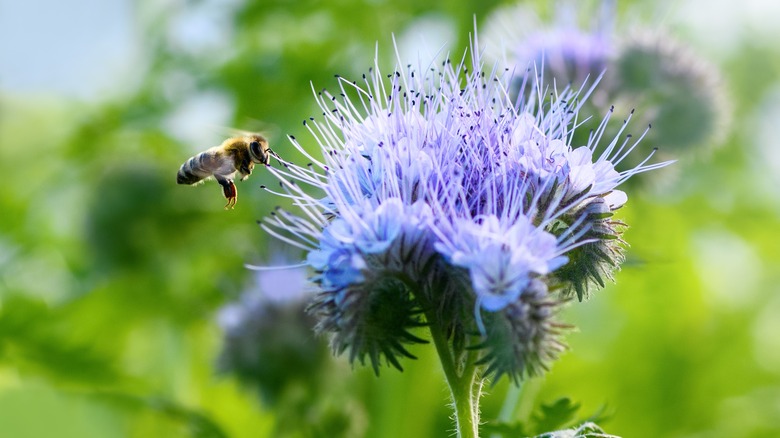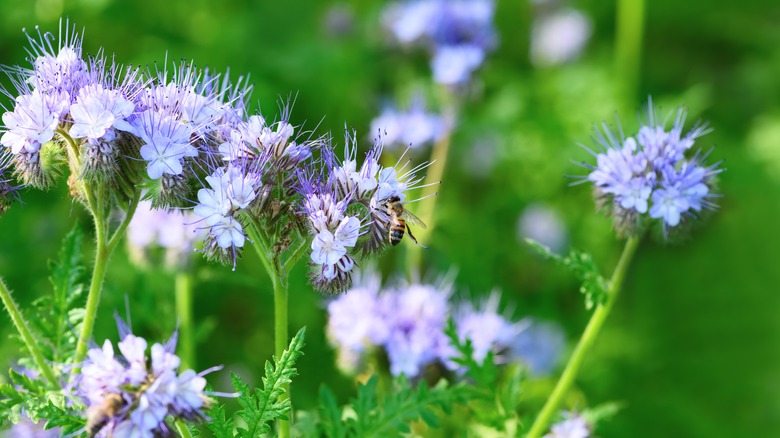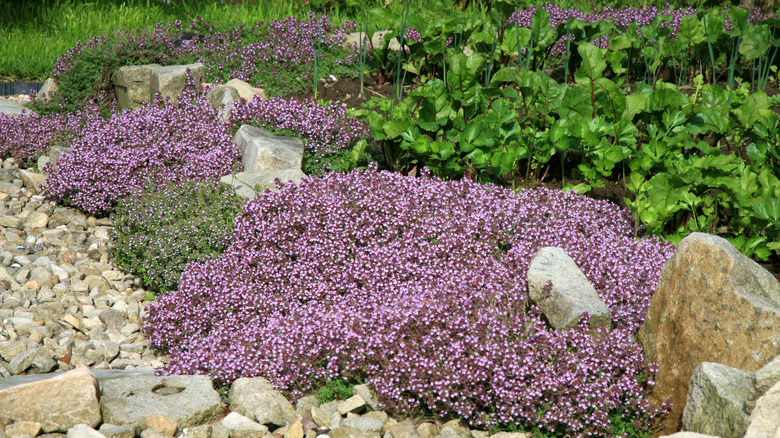Why You Should Reconsider Growing Phacelia In Your Garden
Phacelia, a native flowering plant of North and South America, is characterized by its beautiful clusters of tubular flowers in various shades of blue, purple, or white. Also known as the 'bee's friend,' this plant is popular in many gardens for its ability to attract pollinators and beneficial predatory insects, all while adding elegant pops of color. Phacelia is a relatively low-maintenance flower that can thrive in a variety of soil types and climates. At the same time, it can benefit your garden by suppressing weeds and fixing nitrogen in the soil, a great boon for gardeners growing heavy-feeding edible plants. While all of these characteristics make it seem like an excellent addition to your garden, phacelia is also known to be a potentially invasive species by the United States Department of Agriculture, so you may want to think twice before introducing it to your property.
In certain environments, phacelia can grow rapidly through its prolific seed production. As a result, it can outcompete native plant species in your garden, ultimately disrupting your local ecosystem and threatening the biodiversity around your home. Once phacelia is planted, eradication can be difficult as it spreads aggressively in your garden through root propagation or self-seeding. Many gardeners use this plant as a cover crop due to its weed-suppressing capabilities and its tolerance to cooler climates. Still, it may be safer to consider a native alternative with more manageable growth habits in order to protect your garden and surrounding environment.
When and how to prevent phacelia from self-seeding
If you're not concerned about the invasive tendencies of phacelia and you're interested in reaping its beneficial properties, there are ways to manage it as a cover crop or ornamental flower in your garden without posing too much risk to other neighboring plants. In order to do so, you must understand its blooming period and be ready to jump into action once the time is right. Since phacelia is a self-seeding flowering plant, if left untouched, it will drop seeds after it flowers, and those seeds will allow it to return stronger next season. To disrupt this cycle, you simply need to prevent the seeds from reaching the ground.
Depending on your climate, phacelia blooms throughout the spring and summer. Once you notice the color fading from the flowers, it's go time. Deadhead all the spent flowers by using a clean pair of garden shears and trimming it down to the base of the flower stalk. The timing here is key. If you wait too long after the blooms have faded, you'll allow the plant to develop its seed heads, which can easily fall to the ground, brush up against animals, or blow through the wind. By deadheading immediately after the blooms have faded, you'll prevent any seeds from forming and will end the life cycle of this plant. This process may encourage the plant to flower again, so be on the lookout for additional blooms to deadhead.
Alternatives to phacelia for your garden
Should the self-seeding nature of phacelia and the maintenance it requires to prevent invasive spreading not be in your wheelhouse, several other plants with more reasonable care requirements may be suitable for your climate. One such alternative is lavender. With similar colorful purple blooms, lavender offers a pleasant fragrance that will carry throughout your yard, attracting a number of pollinators. It can also be used in culinary and medicinal ways, making it an excellent choice if cultivating your own lavender may suit your needs beyond the garden.
Another great alternative to phacelia is echinacea. It's also known as coneflower and has blooms similar to daisies, with a large, round center and delicate, colorful petals. It is a pollinator magnet and is tolerant of drought and a number of soil types, making it an excellent choice for different kinds of gardens. But creeping thyme may be the best option for its similar look and habit. While it may not reach the same height, it features many of the same benefits as phacelia. Creeping thyme is a low-maintenance ground cover that is drought-resistant and beautifully fragrant. It develops beautiful purple flowers and has a fragrant aroma, as it is also an herb that can be used in your kitchen. It will help to attract pollinators and it stays green all year round!


